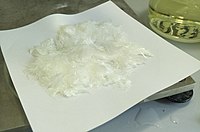
Photo from wikipedia
The present work reports a sustainable adsorption–reduction strategy for disposal of Cr(VI)-bearing wastes. By cross-linking between boehmite and chitosan to prepare amino-functionalized boehmite adsorbents, Cr(VI) could be adsorbed from the… Click to show full abstract
The present work reports a sustainable adsorption–reduction strategy for disposal of Cr(VI)-bearing wastes. By cross-linking between boehmite and chitosan to prepare amino-functionalized boehmite adsorbents, Cr(VI) could be adsorbed from the Cr(VI)-containing solutions by the adsorbents with the maximum adsorption capacity of 120.2 mg/g, which was improved about 3 times compared to that of boehmite. Adsorption mechanism showed that the Cr(VI) was adsorbed by complexing with −NH2 bonds and exchanging with −OH groups of adsorbents. About 31% Cr(VI) was simultaneously reduced to Cr(III) by the reactive −OH and −NH2 electron acceptor of adsorbents. After adsorption, the Cr(VI/III) and boehmite of adsorbents were dissolved in 25% H2SO4 solution, the remaining Cr(VI) was reduced to Cr(III) with 100% reduction yield, and the CrxAl2–x(OH)2y(SO4)8–y·nH2O was prepared as product, while the insoluble chitosan was recycled in a closed loop. In application, column experiments results showed that the γ-AlOOH hazardous ...
Journal Title: ACS Sustainable Chemistry & Engineering
Year Published: 2018
Link to full text (if available)
Share on Social Media: Sign Up to like & get
recommendations!